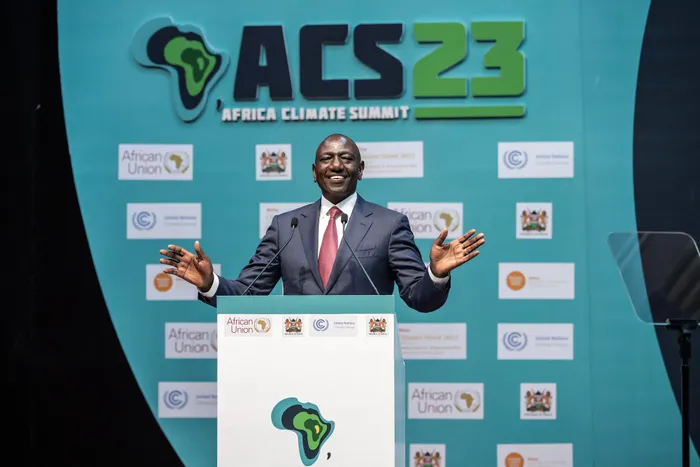Kenya opts for privatisation of state companies to improve

Picture: Luis Tato / AFP / on September 6, 2023 – Kenya’s President William Ruto at the Africa Climate Summit 2023 at the Kenyatta International Convention Centre, Nairobi, in September. The East African economic powerhouse, Kenya, under Ruto, has chosen to embark on a privatisation spree, the writer says.
By Sizo Nkala
The development policy discourse in post-colonial states in Africa has always revolved around the debate on the balance between the roles of the state and the private sector in the national economy.
Upon the end of colonialism in the 1960s, most of the newly independent African countries led by the newly crowned black elite opted for state-led development as a result of the influence of the Soviet Union and its socialist ideals and the prevailing belief that the state was better placed to lead the development process.
Huge swathes of the economy including sectors such as mining, energy, manufacturing, construction, agriculture, tourism, real estate, and transport among others in countries like Nigeria, Kenya, Ghana, Zambia, and Tanzania to mention a few were placed under the state with little role left for the private sector.
Public services such as education, health, water and sanitation, and welfare were also transferred to the control of the state.
It was reasoned that the private sector in most African countries, which was already very small, did not have the capacity nor the appetite to fund the big infrastructure projects needed to transform the economies of post-colonial societies.
Moreover, the state was tasked with redistributing the wealth of the country in order to redress the injustices of colonialism which excluded most indigenous people from the mainstream economy.
However, in the 1980s the failure of state-led development became apparent in most countries due to lack of efficiency and corruption as state companies were used for patronage. Poverty was widespread, economies collapsed, and many countries were left with a debt crisis.
This paved the way for the imposition of Economic Structural Adjustment Programme (ESAP) on desperate African countries at the instigation of the International Monetary Fund (IMF) and the World Bank in the 1980s and 1990s.
One of the central tenets of the ESAP was to roll back the state and let the private sector actors have a more prominent role in the economy. Nonetheless, the ESAP was also a dismal failure as it plunged African countries into a deeper socio-economic crisis and vindicated the staunch advocates of state-led development.
African leaders remain seized with how best to balance the state and private sector roles to produce optimal outcomes. The East African economic powerhouse, Kenya, under President William Ruto, has made its choice by embarking on a privatisation spree.
In October, President Ruto signed the Privatisation Bill into law which effectively replaced the Privatisation Act of 2005. Some of the features of the new legislation include the establishment of the Privatisation Authority, which will spearhead the privatisation programme. The Act stipulates that privatisation can proceed through a variety of methods namely the sale of shares via public tendering, initial public offering, and sales from pre-emptive rights.
Interestingly, Kenyans and non-Kenyans alike will be allowed to buy the state firms up for sale although the responsible Cabinet Secretary is mandated to ensure a minimum participation of Kenyans in a privatising parastatal.
The government has argued that in addition to raising revenue and reducing demand on scarce government resources, privatisation will lead to better regulation of the economy and enable the efficient allocation of resources determined by market forces.
The privatisation drive follows a recent World Bank report which blamed the Kenyan state’s participation in the economy for distorting the market, discouraging private sector investment and thus undermining Kenya’s economic growth.
Moreover, the adoption of the policy coincides with the IMF’s consent to grant Kenya a $938 million loan and the World Bank’s promise of $12 billion in support over the next three years. As such, it seems the trimming of Kenya’s large public sector (over 250 parastatals) was part of the conditions of these deals. This is precisely how ESAP was administered in the 1980s and 1990s.
This week, Ruto set the privatisation programme in motion when he announced that his administration will be privatising 11 parastatals, which is the first batch of 35 parastatals that have been identified and earmarked for privatisation.
The state companies to be privatised include the Kenyatta International Convention Centre (KICC), Kenya Pipeline Company (KPC), New Kenya Cooperative Creameries (KCC), Kenya Seed Company Limited (KSC), National Oil Corporation of Kenya (NOCK), and the Kenya Literature Bureau (KLB) among others.
The reasons cited for the decision to privatise these companies were predominantly that they were operating in a mature economy where the private sector was thriving and that their privatisation would generate additional revenue for the cash-strapped government and reduce pressure on the exchequer.
Only time will tell whether the Kenyan government has made the right decision by privatising the state-owned enterprises. Putting state companies up for sale is not enough to ensure successful privatisation.
Kenya needs to create an environment conducive to attracting private investors and ensure returns on their investments. This includes improving infrastructure, ensuring security, reinforcing the rule of law and revising the regulatory framework.
As history has demonstrated time and again, this is easier said than done. Moreover, the privatisation policy places the hundreds of thousands of Kenyans employed by parastatals at risk of losing their jobs. Depending on how he deals with the prospects of mass retrenchments, Ruto risks losing his political capital.
Dr Sizo Nkala is a Research Fellow at the University of Johannesburg’s Centre for Africa-China Studies